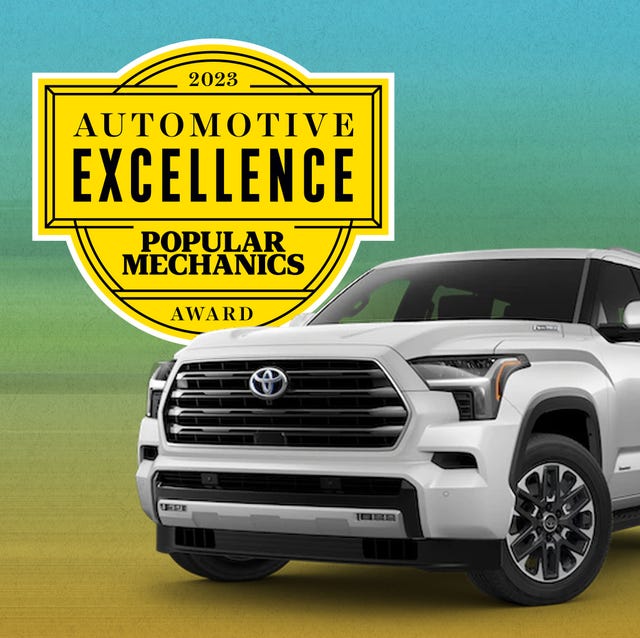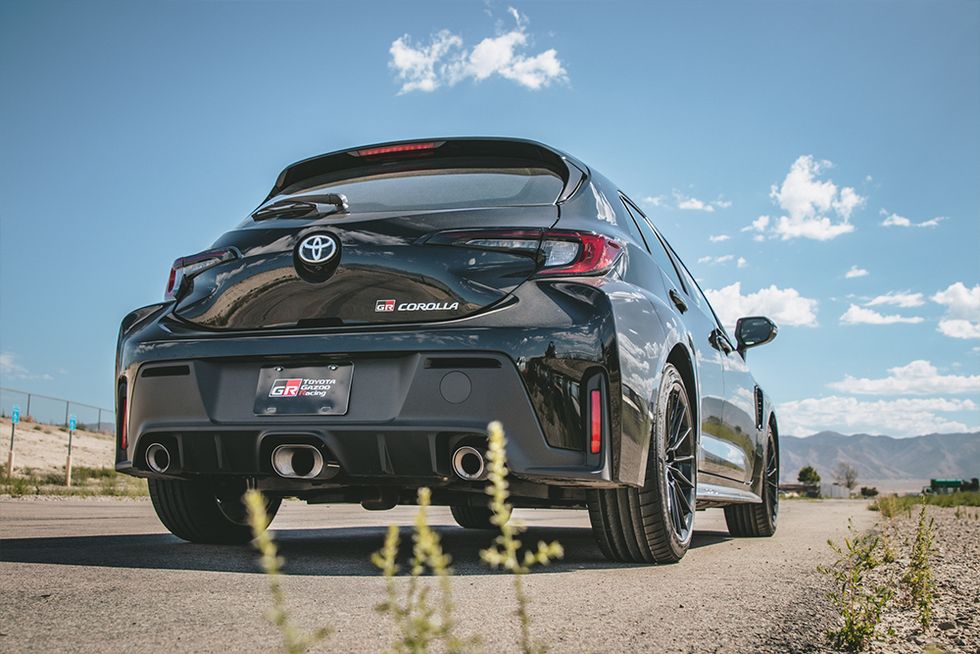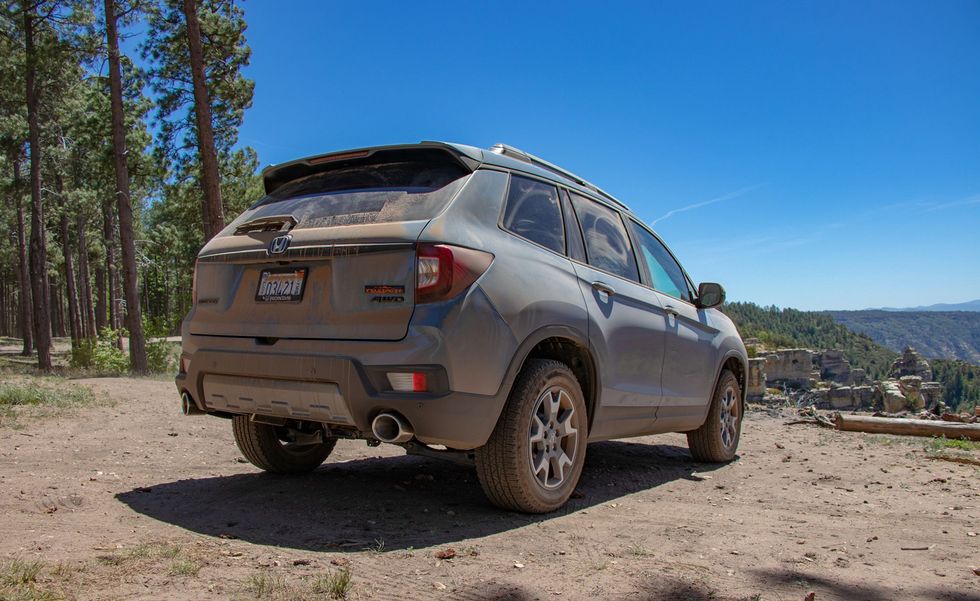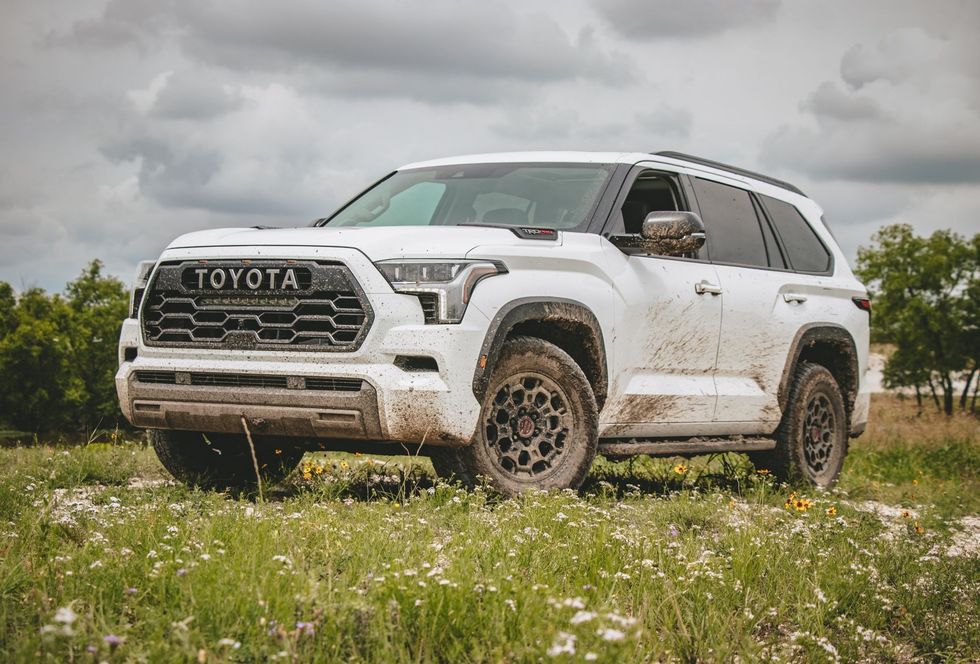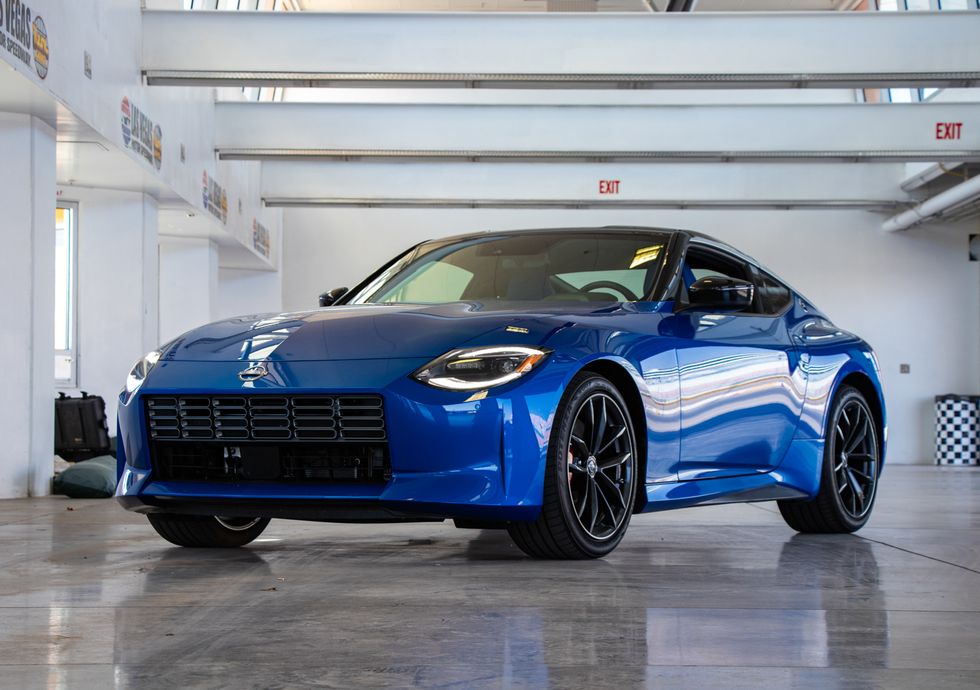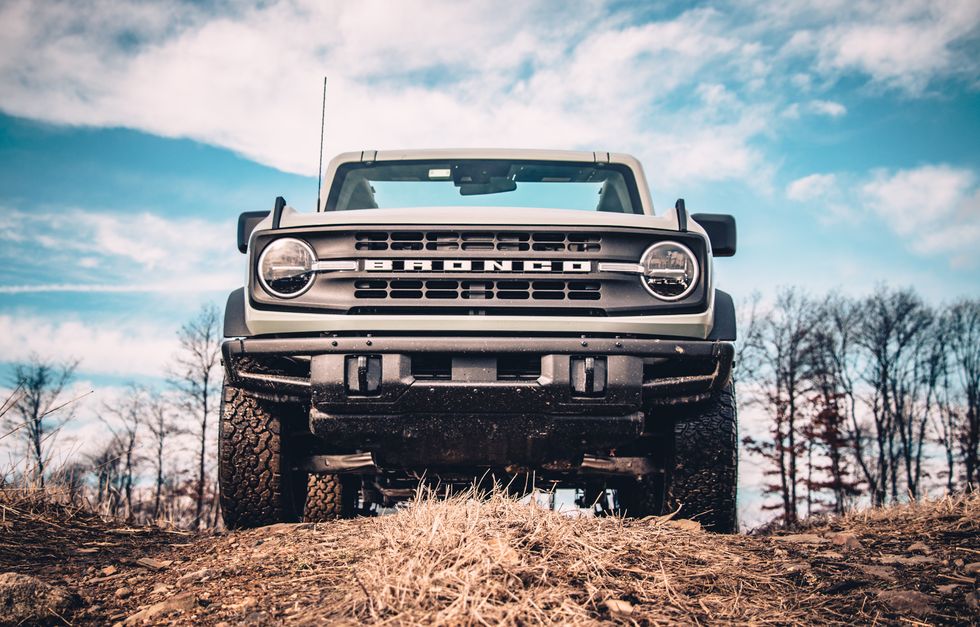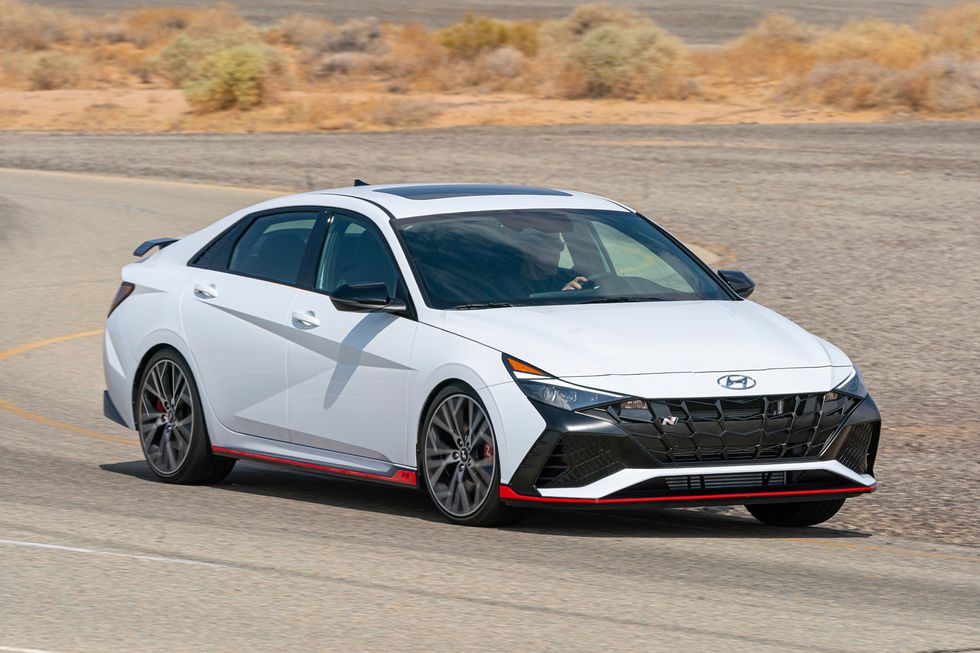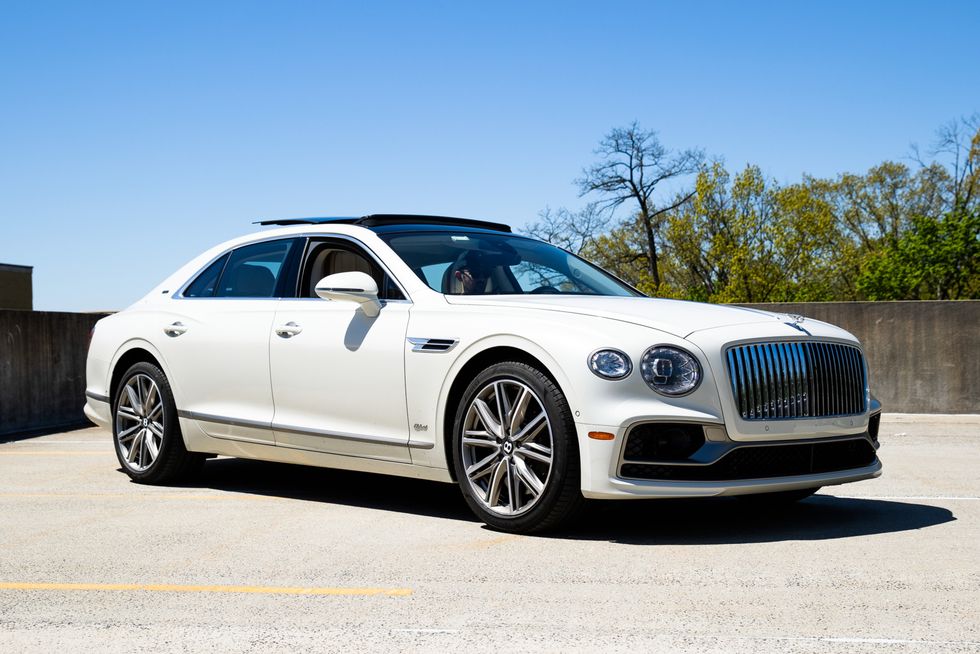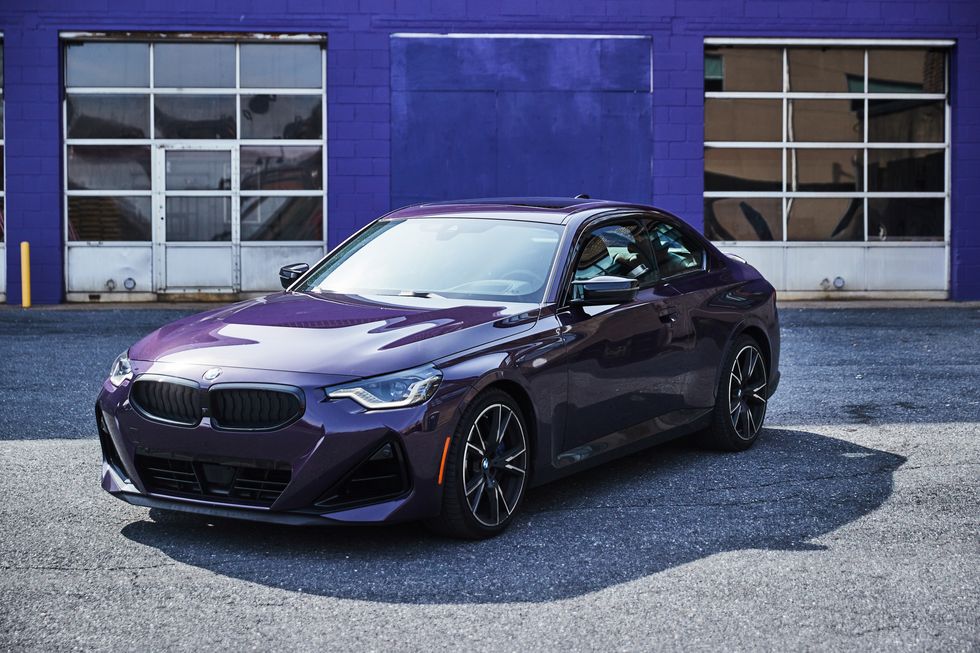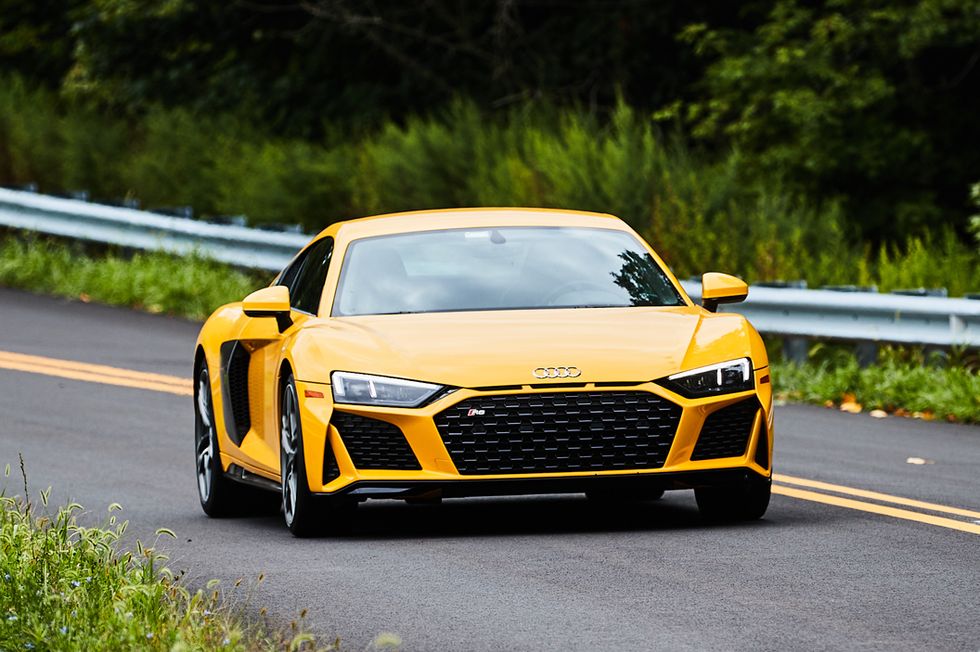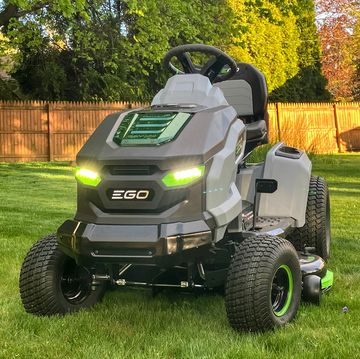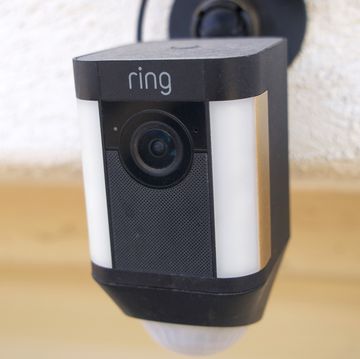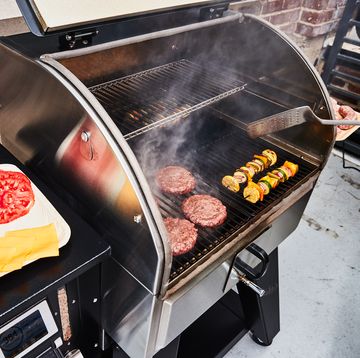Whether you’re just looking for a reliable car that can get you from point A to point B, a track-day warrior, or even a luxury cruiser, you’ll find it here.
- Best Hot Hatchback: Toyota GR Corolla
- Best All-Wheel-Drive Sedan: Subaru WRX
- Best All-Wheel-Drive Off-Roader: Honda Passport Trailsport
- Best Off-Road SUV: Toyota Sequoia TRD Pro
- Best Rear-Wheel-Drive Sports Car: Nissan Z
- Best Off-Roader: Ford Bronco
- Best Family SUV: Kia Telluride
- Best Performance Sedan: Hyundai Elantra N
- Best Luxury Sedan: Bentley Flying Spur Hybrid
- Best All-Wheel-Drive Sports Car: BMW M240i xDrive
- Best Supercar: Audi R8 RWD
BEST HOT HATCHBACK
Toyota GR Corolla
Base price: $35,900 | Engine: Turbocharged 1.6-liter 3-cylinder | Horsepower: 300 hp | Torque: 273 lb-ft | Drivetrain: All-wheel drive
Here in the States, car enthusiasts have been kicking and screaming for Toyota to bring its compact GR Yaris hatchback across the pond. However, rather than altering the Yaris to comply with U.S. safety requirements, Toyota opted to add a stripped-down, pumped-up version of its Corolla hatchback. Earlier this year, I flew to Salt Lake City, Utah, to drive the new GR Corolla on track at Utah Motorsports Campus.
Toyota’s GR-Four all-wheel-drive (AWD) system is one of the clear focal points of the GR Corolla. The Core (with the optional performance package), Circuit, and Morizo editions all come with torsen limited-slip differentials at both axles; these clever diffs send more torque to the wheel with the most grip and are much quicker than a viscous-type limited-slip differential. It almost feels as if the differential sucks the car into the apex of the turn, making the hot hatch feel spunky unlike anything I’ve ever driven. The improved traction was very confidence-inspiring but definitely forced me to get comfortable with how much more speed I could carry through the corners.
New for 2023, the GR Corolla has the same turbocharged, 1.6-liter, three-cylinder engine as the GR Yaris. Despite some bottles holding more soda than the engine displaces air, the Corolla’s powerplant feels strong. Pumping out 300 horsepower and 273 lb-ft of torque, it’s not going to set the world alight. But wow, is it a peppy engine. With peak torque being delivered fairly low down between 3,000 and 5,000 RPM, I could leave the GR Corolla in third gear—sometimes shifting up into fourth—and it had plenty of pep to pull me through some of the slower corners at Utah Motorsports Campus. That’s not to mention that we were at 4,400 feet of elevation, which is not insignificant when it comes to impeding engine power.
I’m happy to report that the gearbox in the GR Corolla is sublime. The throws between gears are weighted very nicely, with the gearstick making a satisfying thunk as it moves into position. Toyota also opted to disable its intelligent manual transmission facility by default. This automatically matches the engine revs when you’re downshifting through the gearbox, and in my eyes is more annoying than it is good. Thankfully, the vehicle doesn’t need it because it’s already well engineered.
—Matt Crisara
BEST ALL-WHEEL-DRIVE SEDAN
Subaru WRX
Base price: $29,605 | Engine: Turbocharged 2.4-liter flat-four | Horsepower: 271 hp | Torque: 258 lb-ft | Drivetrain: Symmetrical all-wheel drive
Unleashed in 1992 as a racing variant of the Impreza, the WRX has staked its claim as one of the most iconic cars in the sport. Unlike previous years, the 2022 variant of the WRX is now its own model. It’s essentially a grassroots rethink of the vehicle on which it was originally based—so much so that it shares absolutely no exterior panels with the Impreza.
The new Subie is packing a turbocharged 2.4-liter flat-four engine—up from the 2.0-liter in the previous car. Sure, it might only produce 3 more horsepower than the engine it replaces, but the end result is much greater than the sum of its parts. Along with the increase in displacement, Subaru tweaked the electronically-controlled turbo wastegate and air bypass valves to find a broader torque curve and improve throttle response. The end result is strong mid-range torque that throws you in the back of your seat.
Our tester was fitted with Subaru’s six-speed manual gearbox, which was an absolute gem. The throws between gears were short and snappy, but the feeling between changes remained intuitive. Subaru says its engineers tinkered with the gear change to improve shift quality, and I believe it. Throughout the week that I had the WRX, I never missed a diagonal shift—second to third, fourth to fifth, and vice versa. However, if you’re not into rowing through the gears yourself, Subaru also offers a continuously variable transmission (CVT) with paddles.
It’s clear that Subaru engineers and designers wanted to level up the fit and finish of its latest WRX, and no area makes that more apparent than the cockpit. Gone are the days of WRX owners hitting vapes and swapping in neochrome shift knobs. Upfront, the gargantuan 11.6-inch Starlink infotainment system made the cockpit feel premium and mature. My only gripe was the lack of physical knobs and buttons for controlling the heated seats and most of the air conditioning functionality.
—MC
BEST ALL-WHEEL-DRIVE OFF-ROADER
Honda Passport Trailsport
Base price: $42,970 ($51,364 as tested) | Engine: Turbocharged 3.5-liter V6 | Horsepower: 280 hp | Torque: 262 lb-ft | Drivetrain: All-wheel drive
Honda’s Trailsport package aims to create a more rugged aesthetic to match the Passport's off-road capabilities. This being an all-wheel-drive crossover, Honda’s target was to create a vehicle that you can use to drop the kids off at school during the week and take them on an all-terrain adventure during the weekend. After putting the vehicle through its paces on myriad roads and trails for over three days at this year’s Overland Expo West in Flagstaff, Arizona, I can confidently say that Honda has met its target.
While the Trailsport package is more of an exercise in design than engineering, Honda says the goal was to highlight the vehicle’s off-road acumen. In evaluating how well the Passport could boogie off-road, we had the chance to tackle “End of The World Trail” in Flagstaff. Those in the know will be aware that it’s no Rubicon trail, but it also wasn’t exactly a walk in the park; most of the route involved hard-packed double track with some off-camber sections throughout. I’m happy to report that the ride remained super comfortable thanks to the coil-sprung independent suspension at both axles.
Honda’s Passport Trailsport rolls out of the factory with 18-inch wheels; EX-L and Elite trims of the Honda Passport come on 20-inch wheels. While this probably sounds largely insignificant, the smaller wheels allow extra room within the wheel arch for a bigger and beefier set of all-terrain tires—allowing for more air volume, which improves comfort on the trail and gives extra headroom for airing down should you need to. However, the biggest benefit is that the Firestone Destination A/T2 tires had much better puncture protection compared to the Passport’s standard all-season tires.
After driving the Passport Trailsport on and off-road for nearly four days, I came to realize that enjoying it is a matter of perspective. A 4x4 will always be more capable on trail. However, Honda’s ruggedized Passport is in a different ballpark when it comes to comfort, handling dynamics, and fuel efficiency—all while being not too shabby when the pavement runs out.
—MC
BEST OFF-ROAD SUV
Toyota Sequoia TRD Pro
Base price: $58,300 ($76,900 as tested) | Engine: Twin-turbocharged 3.4-liter V6 hybrid | Horsepower: 437 hp | Torque: 583 lb-ft | Drivetrain: Selectable four-wheel drive
Toyota’s 2023 Sequoia has been completely revamped for its third generation. It now shares quite a few bits with the Tundra, but that’s not really surprising—or bad—as both are built on the same production line in San Antonio, Texas. Befitting a car named after a massive tree, the Sequoia is a sizable brute with quite a presence and remains a rugged go-anywhere vehicle.
The exterior of the Sequoia features mostly the same angular aesthetic as the Tundra; if you were none the wiser, you’d think it could very well be a Tundra with a bed cover. The biggest differentiating factor is the air dam below the front bumper on non-TRD Pro models. The first row of the interior is much the same story with nearly identical switchgear and infotainment. However, the second row now gets available captain’s chairs with an electric-folding third row in back.
For 2023, Toyota ditched the previous independent rear suspension from the second-gen Sequoia and instead went for a solid rear axle—making it one of the only body-on-frame SUVs in its segment with such a solid rear axle. Many enthusiasts assumed this would make the vehicle ride rough as old bolts on the road. However, the Sequoia’s suspension is buttery smooth. Driving it on the road feels a bit like powder skiing; the body rolls around a little bit, but once the tires bite, direction changes feel sharp.
The Sequoia is the most capable three-row SUV we’ve driven off-road. With access to the whole range at Toyota’s HQ in Plano, Texas, I was able to have a go behind the wheel of the creme-de-la-creme TRD Pro variant; the more affordable TRD Off-Road trim (available for as little as $63,050) proved just about as capable in the dirt with nearly identical all-terrain goodies—cameras, rear locker, suspension lift, etc.
—MC
BEST REAR-WHEEL-DRIVE SPORTS CAR
Nissan Z
Base price: $39,990 ($49,990 as tested) | Engine: Twin-turbo 3.0-liter V6 | Horsepower: 400 hp | Torque: 350 lb-ft | Drivetrain: Rear-wheel drive
When Datsun released the 240Z in 1969, it redefined what a sports car could be in the United States. That car had plenty of power, could properly navigate corners without folding over itself, and was reasonably affordable. Now referred to as just the “Z,” the 2023 iteration is a clear homage to the definitive 240Z. The design department clearly reached deep into its historical cookie jar to create a beautifully eclectic aesthetic. From the driver’s seat, it’s a much better package than the previous 370Z, which was in dire need of improvement.
For 2023, the Z is available in three flavors: sport, performance, and proto specifications. Pricing ramps up rapidly from $39,990 to $49,990 to $52,990, respectively. Throughout the initial drive program, we spent most of the time behind the wheel of Performance-spec cars. Compared to the standard model, these receive bigger wheels, performance brakes, and a clutch-type limited-slip differential for added traction.
Nissan was very proud to announce that the 2022 Z offers 400 horsepower for less than $40,000. Under the hood it uses the same twin-turbocharged VR30DDTT powerplant as the Infiniti Q50 and Q60. Even with it being a VR-series engine, it’s not a direct carryover from the Nissan GTR—which uses the 3.8-liter VR38DETT. Regardless, 400 horses is more than enough with only rear-wheel drive; thankfully, the throttle mapping is excellent. The vehicle was super intuitive, whether I was pushing the envelope at the track or being smooth on the road. This remained true with both the nine-speed automatic and six-speed manual transmission options.
There’s no hiding the fact that the latest Z uses the same chassis as the 370Z. However, it’s been breathed upon by Nissan’s engineers, now featuring more structural rigidity. The added stiffness was very noticeable around the outfield race track outside of Las Vegas Motor Speedway, where the vehicle remained planted through some of the more demanding high- and medium-speed bits of the track. Having said that, I’m pleased that the suspension remained soft and supple throughout the road drive that followed. Sure, this is no Rolls Royce. But the Z is perfectly usable for daily driving.
—MC
BEST OFF-ROADER
Ford Bronco
Base price: $36,450 | Engine: Turbocharged 2.3-liter 4-cylinder | Horsepower: 300 hp | Torque: 325 lb-ft | Drivetrain: Selectable four-wheel-drive
Earlier this year, we gave the latest Bronco a proper workout out on the trails at Rausch-Creek Off-Road Park. Our 2022 tester was a fairly basic two-door Black Diamond model fitted with a manual transmission.
During the 75-mile journey to Rausch, the Bronco felt quite soft on the road, but that’s to be expected—even with its independent front suspension. Having said that, the steering is weighted really nicely, and there are plenty of creature comforts to keep you occupied behind the wheel. Apple CarPlay was a joy to use on the 8-inch infotainment screen, keeping my favorite Willie Nelson tunes booming through the stereo.
While the Bronco was perfectly usable on the road as a daily driver, it’s not a parking lot princess. Throw it in 4Low, and it’s an off-road savant. Rolling on 32-inch diameter all-terrain tires, our non-Sasquatch model was plenty capable even in some of the rockier sections of trail. The added ground clearance with the optional 35-inch tires would have been nice but simply isn’t necessary. Rausch Creek’s park manager, Bernie Gardula, took me up an ultra-steep “pro-line” of sorts on their grounds, and the Bronco tackled it with ease.
The seven-speed manual transmission—six-speed with a crawler gear—paired with the low-range gearbox was awesome to use. While first gear was adequate for most bits of trail, the much shorter crawler gear (6.588:1) allowed me to finesse my way through technical sections just the way I wanted. Even though I never really needed to slip the clutch, the pedal engagement was really intuitive. I fully trusted the third pedal, even with Gardula mere inches from the front bumper, guiding me through some of the tough points.
—MC
BEST FAMILY SUV
Kia Telluride
Base price: $44,590 | Engine: 3.8-liter V6 | Horsepower: 291 hp | Torque: 262 lb-ft | Drivetrain: All-wheel drive
The Telluride is an exceptionally luxurious automobile. However, things used to be different. Before a comprehensive rebrand in the early 2000s, the Korean automaker had long been the butt of many automotive jokes. Following its resurgence in the 2010s, J.D. Power named Kia the Number 1 Brand in its 2016 Initial Quality Study.
One of the fundamentals of a great luxury automobile is a comfortable ride that disconnects its passengers from the road. While the springs and dampers in the Telluride aren’t perfect, they soak up bumps exceptionally well. However, the supple suspension also keeps body roll in check, meaning that Kia’s 4,500-pound SUV remains poised in the corners.
All Telluride models arrive from factory with Kia’s Highway Driving Assistance (HDA), a level-two autonomous driving system. In giving the vehicle a proper workout, we tried HDA on the roads near Blue Mountain ski resort in Carbon County, Pennsylvania. Whether we were on a roughly marked country lane or a picture-perfect highway, Kia’s SUV could drive itself unaided for quite a while before experiencing any issues. The system was commonly confused when lanes appeared or disappeared, but I’ve driven much more expensive vehicles that had similar trouble.
The driver and passenger in our top-of-the-line Telluride SX test rig get to enjoy 10- and 8-way adjustable heated and ventilated seats, respectively. Second-row accommodations weren’t much of a downgrade, with electrically adjustable captain’s chairs—that also included heating and cooling. Out back, you also get four USB ports along with a 115-volt wall outlet, a 12-volt socket, and a massive moonroof to look through.
—MC
BEST PERFORMANCE SEDAN
Hyundai Elantra N
Base price: $32,150 | Engine: Turbocharged 2.0-liter 4-cylinder | Horsepower: 276 hp | Torque: 289 lb-ft | Drivetrain: Front-wheel drive
Hyundai’s Elantra N replaces the Veloster N, which was discontinued for the 2023 model year—meaning only the Elantra and Kona get the N treatment. It’s the new kid on the block, and while it might be aesthetically polarizing, it’s one of the best sports sedans that we’ve driven all year.
The Elantra N features the same turbocharged 2.0-liter powerplant as the Veloster N. Cranking out up to 286 hp with its new overboost function, the four cylinder shines low in the rev range with surprisingly rambunctious power delivery. This inherent vim and vigor helped me scurry away after making an absolute mess out of the tight confines of Atlanta Motorsports Park. I inevitably kept missing the apex in the same sequence of corners—killing my momentum. Critically, the crisp acceleration also proved super useful on the road when merging onto the highway and shooting gaps around the city.
Power is great, but cornering performance is the real meat and potatoes of the Elantra N. As standard, the vehicle comes with a sticky set of 245 section Michelin Pilot Sport 4S tires, which are a great balance for road and track use. Elantra N also comes with a limited-slip differential (LSD), which produces hilarious amounts of grip in the corners. These differentials get their name because they send engine power to the wheel with the most grip and limiting the slip of the wheel with the least traction.
Despite packing such a small powerplant, the Elantra N lets out an aggresive exhaust note—adding to its already sporty characteristics. Like many hot hatchbacks, the optional dual-clutch transmission (automatic transmission) variant lets out pops and bangs when you let off the gas and change gear. Sure, plenty of hot hatchbacks let out the same type of cannon fire, but none of them quite match the energy of the Elantra N. You don’t get as much noise with the standard six-speed manual, but the driving experience is so much more engaging when rowing through the gears yourself.
On paper, Hyundai’s latest sports sedan doesn’t really look like a widowmaker. However, it still manages to punch well above its weight when you get behind the wheel and drive it.
—MC
BEST LUXURY SEDAN
Bentley Flying Spur Hybrid
Base price: $210,000 | Engine: Twin-turbocharged 2.9-liter V6 hybrid | Horsepower: 536 hp | Torque: 553 lb-ft | Drivetrain: All-wheel drive
Bentley’s Flying Spur Hybrid is another one of the brand’s steps toward electrifying its lineup by 2030. It started with the Bentley Bentayga Hybrid in 2021, which was then followed by this Flying Spur Hybrid.
Bentley’s all-new hybrid V6 powertrain is a bit of a departure from the norm; unlike the more shock-and-awe V8 and W12 configurations that are available, the V6 hybrid turns gasoline into silence. The luxury British automaker is proud of the increases in efficiency—20 mpg (combined) compared to 17.5 in the V8—but also made a point to mention the advantages in terms of quietness. “From the outset, we said this was going to be one of the most refined Bentleys ever made,” says John O’ Sullivan, Functional Manager of Chassis NVH & Structural Dynamics at Bentley Motors.
The Flying Spur Hybrid is 50 percent quieter at 50 mph compared to the V8 thanks to its all-electric drive mode. Powered by a 18-kWh lithium-ion battery, the hybrid system can propel the vehicle for just above 24 miles when in all-electric mode. “We’ve omitted one of the major sound sources, which helps, but then of course other noises become apparent,” says O’ Sullivan. One of the loudest is the whir of the electric motor; these noises are different from the grumble of an internal combustion because they’re much higher frequency, which Bentley’s engineers say can be annoying.
The luxury driving experience is often all about disconnecting the driver from the road ahead. Along with the worry that a small bump might knock your glass of Möet & Chandon out of your hand, these slight jolts are generally just uncomfortable. Some vehicles (including the Lincoln Aviator we drove last year) use a system of cameras that scan the road ahead. However, others—like this Flying Spur—have accelerometers in the suspension to detect bumps as they’re rolling over them. In fact, it only takes the vehicle 10 milliseconds to react to a bump and independently adjust the suspension settings at all four corners accordingly. Case in point: If it detects a wheel going over a bump, it can soften the spring rate to cope.
—MC
BEST ALL-WHEEL-DRIVE SPORTS CAR
BMW M240i xDrive
Base price: $35,900 | Engine: Turbocharged 1.6-liter 3-cylinder | Horsepower: 300 hp | Torque: 273 lb-ft | Drivetrain: All-wheel drive
Rather unsurprisingly, BMW’s M240i ticks all of the boxes that make a great sports car: vast reserves of power, excellent handling characteristics, and a luxurious interior. My one week with the all-wheel-drive brute mostly involved short bursts through the twisty farm roads just outside the Popular Mechanics office in eastern Pennsylvania. However, I also took a longer drive up to Pine Grove, Pennsylvania, to evaluate the new Bimmer’s demeanor on the highway.
In terms of power, the M240i is comfortably one of the quickest cars that I’ve driven. Under the hood, it has the same 382-horsepower, turbocharged, 3.0-liter engine as the M440i. However, with less weight to haul around—3,871 pounds compared to the 4,169-pound M440i—the smaller M240i is much quicker.
Subtracting weight will always improve cornering ability. However, BMW’s xDrive all-wheel-drive (AWD) system is the clear star of the show here. Regardless of whether I was driving in cold and wet or warm and dry conditions, I had way more traction than I would ever need on the road. Our tester was still fitted with winter tires—which weren’t nearly as grippy as Michelin’s Pilot Sport 4 S all-season tires that come standard—and I was impressed by the amount of grip.
The M240i’s interior is textbook BMW, providing just the right balance of comfort, luxury, and sportiness. Case in point: The driver’s seat remained super comfortable during longer road trips while holding me in tight during spirited drives. The seat and steering wheel were super easy to adjust to get my driving position dialed in right where I wanted it. This is something that I don’t take lightly, as it leads to a more comfortable and engaging experience behind the wheel. With BMW’s heads-up display, I also never had to take my eyes off the road to look at pertinent information.
—MC
BEST SUPERCAR
Audi R8 RWD
Base price: $148,700 ($187,095 as tested) | Engine: 5.2-liter V10 | Horsepower: 562 hp | Torque: 406 lb-ft | Drivetrain: Rear-wheel drive
You’re probably surprised to see a supercar review start by mentioning practicality. These machines have a track record of being anything but. However, the R8 is genuinely usable as an everyday supercar. When you’re not giving it the beans, it’s pretty easy to live with on a daily basis—though that’s not to say it’s a no-compromises daily driver.
Keen supercar enthusiasts will note that it doesn’t have a front axle lift. This feature has become a staple on most supercars, lifting the nose to avoid scraping it on steep approaches—think of situations like a driveway, harsh curb cut, or even an uphill intersection. However, the R8 simply doesn’t need this because the front end is already tall enough that it clears most of these obstacles.
When you buy an Audi R8, you’re getting many things for your dollar. However, its 5.2-liter V10 engine that revs to 10,000 rpm is a significant piece of its supercar puzzle. It’s the same powerplant that you get in the Lamborghini Huracan, and it’s an absolute tour de force. It triumphantly converts gasoline into noise, celebrating the occasion with one of the most special exhaust notes I’ve ever heard; it sounds feral, almost like a wild animal that’s angry about something. I’ve never driven a car that makes so many different noises while climbing through the rev range. It growls low-down in the revs, snarls in the middle, and roars at the top.
The living quarters of any high-dollar luxury cruiser or supercar always have a very particular feel. However, if the interior of Bentley’s Flying Spur aims to replicate the lobby of a luxury hotel, the inside of the R8 feels like the cockpit of Maverick’s F-18 fighter jet. A quick look at the steering wheel shows buttons galore, with four driver-select toggles located under all of the media controls that you’d expect on a modern automobile. It doesn’t necessarily make you feel like a Formula 1 driver, but it definitely makes you feel special.
—MC
Matt Crisara is a native Austinite who has an unbridled passion for cars and motorsports, both foreign and domestic. He was previously a contributing writer for Motor1 following internships at Circuit Of The Americas F1 Track and Speed City, an Austin radio broadcaster focused on the world of motor racing. He earned a bachelor’s degree from the University of Arizona School of Journalism, where he raced mountain bikes with the University Club Team. When he isn’t working, he enjoys sim-racing, FPV drones, and the great outdoors.
